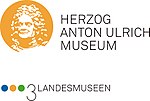Johann Ferdinand Friedrich Emperius
Johann Ferdinand Friedrich Emperius (born January 23, 1759 in Braunschweig ; † October 21, 1822 there ) was a German university teacher, museum director and Braunschweig court advisor.
life and work
The son of a post office administrator studied theology and philology in Göttingen from 1776 before going to the University of Cambridge in England for several years . In 1781, Johann Ferdinand Friedrich Emperius was accepted into the Braunschweig Freemason Lodge " Carl to the Crowned Column ". He returned to Braunschweig in 1788, where he became a full professor of classical literature at the Collegium Carolinum . In 1801 he was appointed councilor.
Museum director and professor in Braunschweig
In September 1806 Emperius was appointed director of the ducal art and natural history cabinet , the forerunner of today's Herzog Anton Ulrich-Museum , in Braunschweig. During the time of the Kingdom of Westphalia he gave lessons in history and English at the Collegium Carolinum, which was converted into a military school. In 1813 he received a canonical at the Cyriakus pen . After the end of Napoleonic rule, Emperius campaigned for the restoration of the Collegium Carolinum, of which he became co-director in 1814. He accepted a teaching position in classical and English literature.
Return of the looted art
During the Napoleonic occupation, large numbers of art treasures from all over Europe, including the Herzog August Library in Wolfenbüttel and the Salzdahlum Picture Gallery, were brought to Paris to be added to the "Musée Napoleon" founded in 1803. The “art thief by the grace of the emperor”, Baron Dominique Vivant Denon , inspected the Brunswick collections for several days to select the most valuable pieces. The loot boxes reached Paris in 1807. Only after the defeat of Waterloo in 1815 did commissioners, including Emperius, travel to Paris from all over Europe to identify the loot and bring it back. This was laborious in that the art objects were not only found in the Louvre , but also in provincial museums, castles and churches. The paintings of the Salzdahlumer Galerie, which were brought back to Braunschweig with few losses, were combined with the collections of the art and natural history cabinet in the former Pauline monastery .
Emperius was married to Dorothea Sophie Henriette Eisenbiel (1771-1820). He died in Braunschweig in 1822.
literature
- Horst-Rüdiger Jarck , Günter Scheel (Ed.): Braunschweigisches Biographisches Lexikon - 19th and 20th centuries . Hahnsche Buchhandlung, Hannover 1996, ISBN 3-7752-5838-8 , p. 163 .
- Norman-Mathias Pingel: Emperius, Johann Ferdinand Friedrich in: Manfred Garzmann , Wolf-Dieter Schuegraf (Ed.): Braunschweiger Stadtlexikon . Supplementary volume. Joh. Heinr. Meyer Verlag, Braunschweig 1996, ISBN 3-926701-30-7 , p. 41 .
- Ferdinand Spehr : Emperius, Joh. Ferd. Friedrich . In: Allgemeine Deutsche Biographie (ADB). Volume 6, Duncker & Humblot, Leipzig 1877, p. 93 f.
Web links
- Literature by and about Johann Ferdinand Friedrich Emperius in the catalog of the German National Library
Individual evidence
- ↑ Mechthild Wiswe : Freemasons in their time. Accompanying publication to the exhibition of the Braunschweigisches Landesmuseum on the 250th anniversary of the Braunschweig Masonic lodges, Braunschweig 1994, ISBN 978-392793923-3 , p. 41.
| personal data | |
|---|---|
| SURNAME | Emperius, Johann Ferdinand Friedrich |
| BRIEF DESCRIPTION | German university professor, museum director and Braunschweig councilor |
| DATE OF BIRTH | January 23, 1759 |
| PLACE OF BIRTH | Braunschweig |
| DATE OF DEATH | October 21, 1822 |
| Place of death | Braunschweig |
